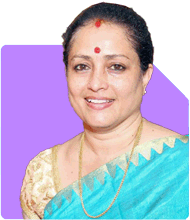Ramalingam Kalirajan |4357 Answers |Ask -Follow
Mutual Funds, Financial Planning Expert - Answered on Jul 05, 2024
He has an MBA in finance from the University of Madras and is a certified financial planner.
He is the director and chief financial planner at Holistic Investment, a Chennai-based firm that offers financial planning and wealth management advice.... more

Hi dev, i earn 1,44 000 per month. I am 33 years old, Around 18000 per month my money goes into LIC jeevan labh yojana. Remaining i give around 40k to my parents as a help monthly. If i cut 10000 as monthly expenditure, how should i invest around 70k per month to get maximum returns.How should be the split.Please suggests SIPs to invest in.
Understanding the Investment Landscape
Investing Rs. 70,000 monthly is substantial. We need to allocate it across various instruments to balance risk and return. Mutual funds are excellent for this purpose due to their diverse options, liquidity, and potential for high returns. Mutual funds pool money from various investors to invest in diversified portfolios. This diversification reduces risk and allows professional management.
Categorizing Mutual Funds
Mutual funds can be categorized based on the underlying assets. Here are some categories to consider:
1. Equity Funds
Equity funds invest in stocks. They can be further classified into large-cap, mid-cap, and small-cap funds based on the companies' market capitalization they invest in.
Large-Cap Funds: Invest in large, well-established companies. They are less volatile and offer steady growth.
Mid-Cap Funds: Invest in mid-sized companies with potential for high growth. They are riskier than large-cap funds but can provide higher returns.
Small-Cap Funds: Invest in smaller companies. They are the most volatile but offer the highest growth potential.
2. Debt Funds
Debt funds invest in fixed income instruments like bonds and treasury bills. They are less risky than equity funds and provide steady returns.
3. Hybrid Funds
Hybrid funds invest in a mix of equity and debt. They offer a balanced approach, providing growth potential and stability.
Splitting Your Investment
To achieve maximum returns while managing risk, a balanced allocation across different mutual fund categories is advisable. Here’s a suggested split for your Rs. 70,000 monthly investment:
Equity Funds (50% - Rs. 35,000)
Equity funds should form the bulk of your portfolio, given their high return potential. Within equity funds, diversify across large-cap, mid-cap, and small-cap funds.
Large-Cap Funds (20% - Rs. 14,000): These funds are relatively stable and provide moderate returns.
Mid-Cap Funds (15% - Rs. 10,500): These funds have a higher growth potential with moderate risk.
Small-Cap Funds (15% - Rs. 10,500): These funds are high-risk but can offer significant returns.
Debt Funds (30% - Rs. 21,000)
Debt funds provide stability and reduce overall portfolio risk. Allocate around 30% of your investment here.
Short-Term Debt Funds (15% - Rs. 10,500): These funds are less affected by interest rate changes.
Long-Term Debt Funds (15% - Rs. 10,500): These funds offer higher returns but come with interest rate risk.
Hybrid Funds (20% - Rs. 14,000)
Hybrid funds offer a balanced mix of equity and debt. They are suitable for medium-term goals and provide a cushion against market volatility.
Aggressive Hybrid Funds (10% - Rs. 7,000): These funds invest primarily in equity but have a significant debt component.
Conservative Hybrid Funds (10% - Rs. 7,000): These funds have a higher debt component, offering more stability.
Advantages of Mutual Funds
Professional Management
Mutual funds are managed by professional fund managers. They make informed decisions based on research and market analysis. This expertise can significantly enhance your returns.
Diversification
Investing in mutual funds offers diversification, spreading your investment across various assets. This reduces risk, as poor performance in one asset is balanced by better performance in another.
Liquidity
Mutual funds are highly liquid. You can buy and sell mutual fund units on any business day, providing flexibility to access your money when needed.
Compounding
Mutual funds benefit from the power of compounding. Reinvesting your returns allows your investment to grow exponentially over time.
Risk Assessment
While mutual funds offer high returns, they come with risks. Here are some key points to consider:
Market Risk
Equity funds are subject to market risk. The value of your investment can fluctuate with market conditions. However, long-term investment in equity funds usually mitigates this risk.
Interest Rate Risk
Debt funds are affected by changes in interest rates. Rising interest rates can reduce the value of existing bonds in a debt fund's portfolio. Short-term debt funds are less affected by this risk.
Credit Risk
Debt funds also face credit risk, the risk of default by issuers of the bonds they hold. Investing in high-quality debt funds can reduce this risk.
Evaluating the Disadvantages of Index Funds
While index funds are popular, they have some drawbacks compared to actively managed funds. Index funds track a specific index and cannot outperform the market. In contrast, actively managed funds aim to beat the market through strategic investments. Fund managers of actively managed funds use their expertise to select high-potential stocks, offering better returns.
Benefits of Investing Through Certified Financial Planners
Investing through a Certified Financial Planner (CFP) has advantages over direct investments. CFPs provide personalized advice based on your financial goals, risk tolerance, and investment horizon. They help you select the right mutual funds, monitor your investments, and make adjustments as needed. Their expertise ensures your investments are aligned with your financial goals.
Your disciplined approach to financial management is commendable. Allocating funds for family support and future investments shows foresight and responsibility. Your commitment to making the most of your income is inspiring and deserves appreciation.
Balancing financial obligations while planning for the future is challenging. Your efforts to secure a strong financial foundation for yourself and your family reflect a deep sense of responsibility. It's clear you care about providing for your loved ones while also striving for personal financial growth.
Final Insights
Investing Rs. 70,000 per month in a diversified portfolio of mutual funds is a smart move. By balancing equity, debt, and hybrid funds, you can maximize returns while managing risk. Remember to review your investments regularly and adjust based on performance and changing financial goals.
Your proactive approach to financial planning sets a strong example. With careful management and the right investments, you can achieve significant financial growth and security.
Best Regards,
K. Ramalingam, MBA, CFP,
Chief Financial Planner,
www.holisticinvestment.in
You may like to see similar questions and answers below
Omkeshwar Singh | Answer |Ask -Follow
Head, Rank MF - Answered on Nov 02, 2022
Sunil Lala |193 Answers |Ask -Follow
Financial Planner - Answered on Jan 19, 2024
Ramalingam Kalirajan |4357 Answers |Ask -Follow
Mutual Funds, Financial Planning Expert - Answered on Apr 17, 2024
Ramalingam Kalirajan |4357 Answers |Ask -Follow
Mutual Funds, Financial Planning Expert - Answered on Jun 05, 2024
Dr Shyam Jamalabad |61 Answers |Ask -Follow
Dentist - Answered on Jul 08, 2024
Dr Shyam Jamalabad |61 Answers |Ask -Follow
Dentist - Answered on Jul 08, 2024
Dr Karthiyayini Mahadevan |865 Answers |Ask -Follow
General Physician - Answered on Jul 08, 2024
Dr Karthiyayini Mahadevan |865 Answers |Ask -Follow
General Physician - Answered on Jul 08, 2024
Dr Shyam Jamalabad |61 Answers |Ask -Follow
Dentist - Answered on Jul 08, 2024
Dr Karthiyayini Mahadevan |865 Answers |Ask -Follow
General Physician - Answered on Jul 08, 2024
Dr Karthiyayini Mahadevan |865 Answers |Ask -Follow
General Physician - Answered on Jul 08, 2024
Dr Karthiyayini Mahadevan |865 Answers |Ask -Follow
General Physician - Answered on Jul 08, 2024
Dr Karthiyayini Mahadevan |865 Answers |Ask -Follow
General Physician - Answered on Jul 08, 2024
Dr Karthiyayini Mahadevan |865 Answers |Ask -Follow
General Physician - Answered on Jul 08, 2024














.jpg)







